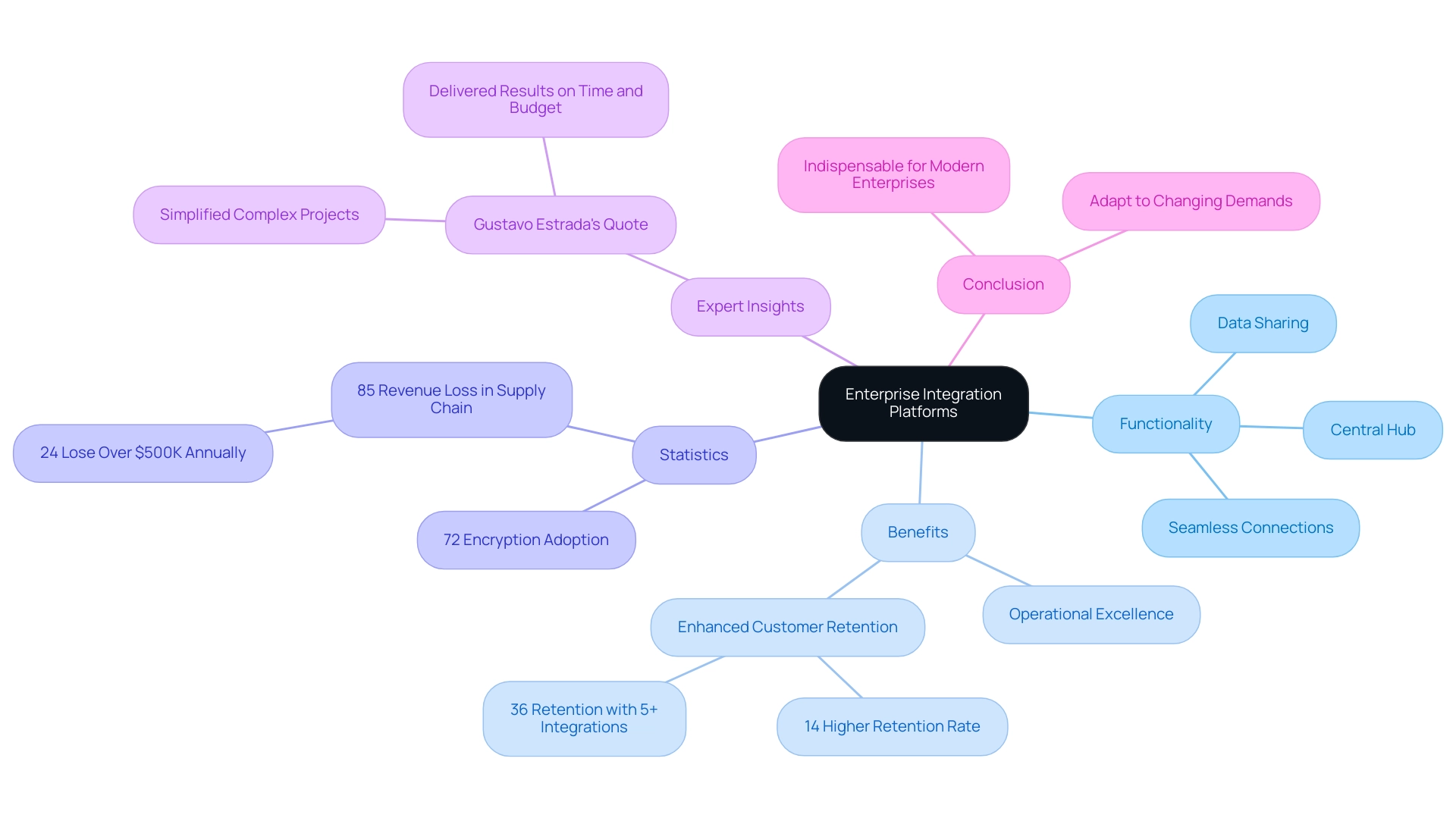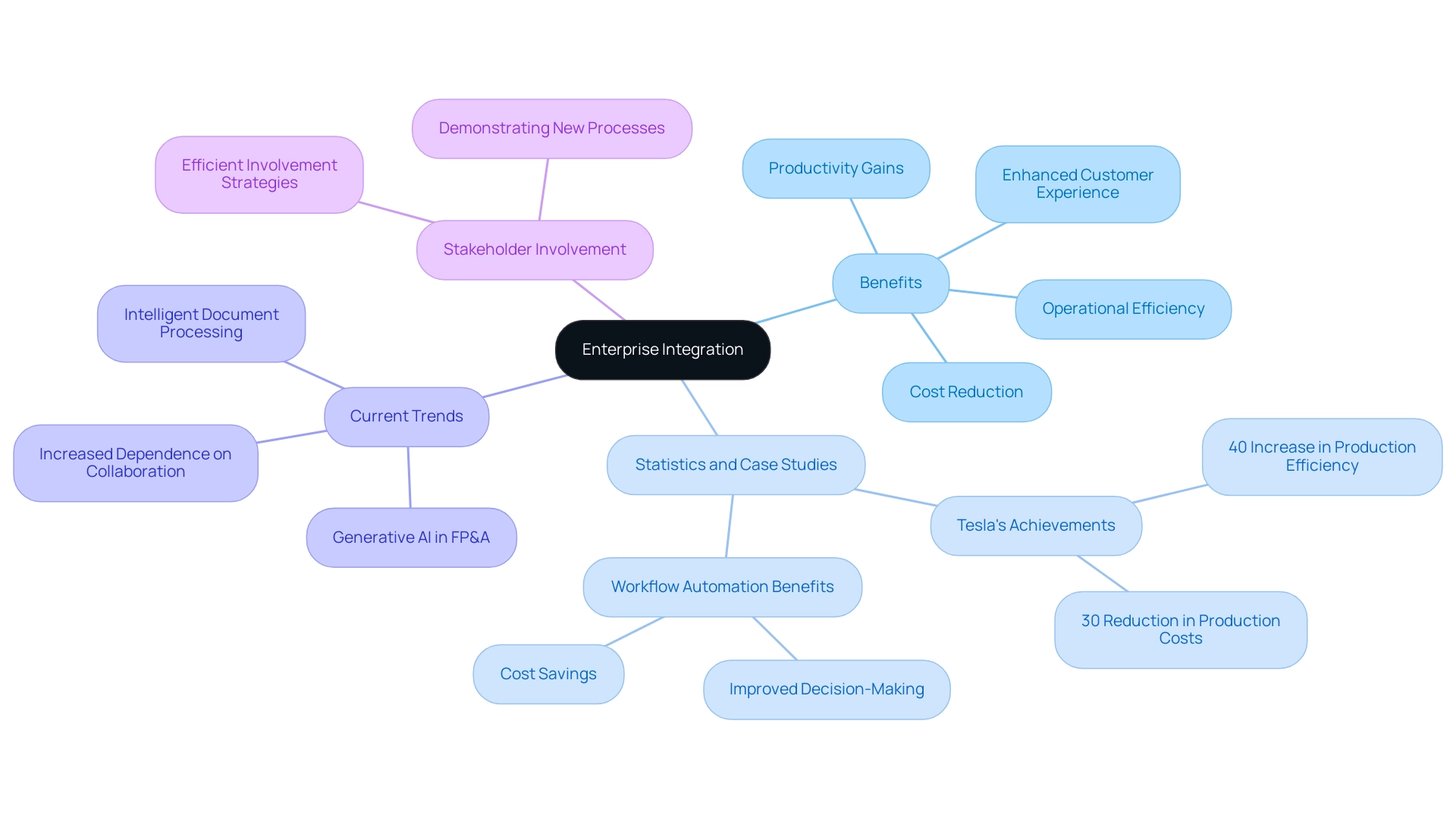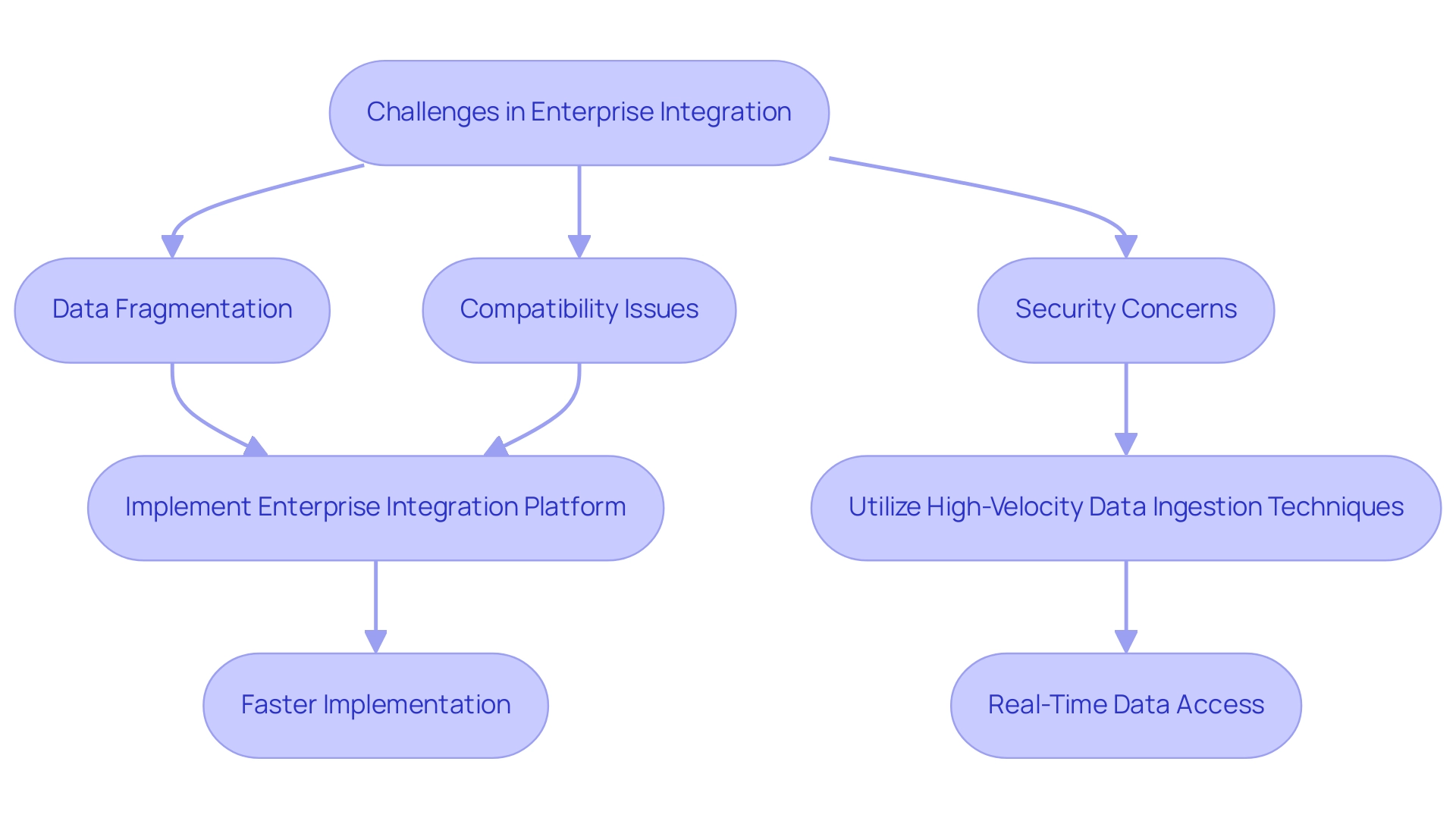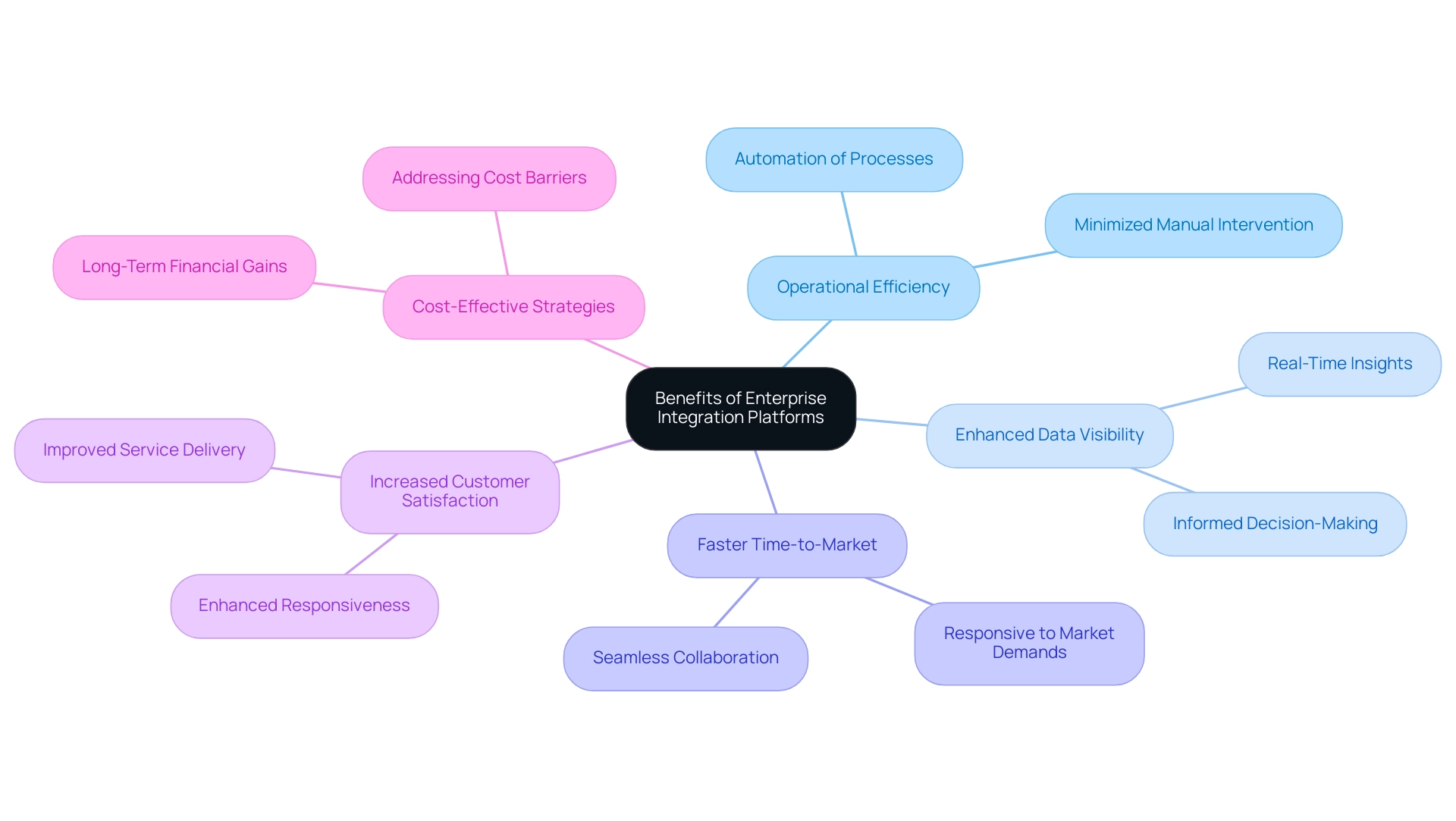Overview
An enterprise integration platform (EIP) serves as a vital software solution, facilitating seamless communication and data sharing among diverse systems and applications within an organization. This capability significantly enhances operational efficiency and decision-making.
As businesses strive to streamline processes, reduce costs, and elevate customer satisfaction, the adoption of EIPs becomes increasingly essential. Statistics reveal substantial revenue losses attributed to inadequate system connections, highlighting the critical nature of these integrations.
Furthermore, effective utilization of EIPs positively impacts user retention rates, underscoring their value. How prepared is your organization to leverage such a transformative tool? The evidence is clear: integrating systems is not just beneficial; it is imperative for success in today’s competitive landscape.
Introduction
In the fast-evolving digital landscape of 2025, enterprise integration platforms (EIPs) have emerged as essential tools for organizations striving to enhance operational efficiency and maintain a competitive edge. These platforms serve as the backbone of seamless connectivity, enabling disparate systems and applications to communicate and share data effectively. As businesses increasingly confront challenges such as data fragmentation and the need for real-time insights, the significance of EIPs becomes even more pronounced.
By leveraging advanced integration solutions like Avato’s hybrid platform, organizations can not only streamline processes but also unlock substantial business value. This paves the way for innovation and growth in an interconnected world. The journey towards effective enterprise integration is not without its complexities. However, the rewards are substantial for those willing to embrace this transformative technology. Are you ready to take the next step in enhancing your organization’s capabilities?
Defining Enterprise Integration Platforms: A Comprehensive Overview
An enterprise integration platform (EIP) serves as a vital software solution that facilitates seamless connections among various systems, applications, and data sources within an organization. Acting as a central hub, the enterprise integration platform allows disparate software applications to communicate and share data efficiently, thereby eliminating data silos and streamlining processes. This integration is essential for enhancing operational effectiveness, as it provides entities with a cohesive view of their activities, which is crucial for informed decision-making and strategic planning.
As we look toward 2025, a significant percentage of organizations are leveraging enterprise integration platforms to modernize their operations. Reports indicate that 72% of businesses have adopted encryption solutions, highlighting an increasing emphasis on security within processes. The company, prioritizing security, addresses these challenges by offering a hybrid platform that ensures secure and efficient connections among systems, particularly in sectors such as banking, healthcare, and government, where continuous uptime is paramount.
Furthermore, a recent study revealed that 85% of supply chain firms believe they are losing revenue due to inadequate software system connections, with 24% estimating losses exceeding $500,000 annually. These statistics underscore the pressing need for effective integration solutions in today’s business landscape, and the company’s offerings are designed to mitigate these losses by simplifying complex integrations and maximizing the value of legacy systems.
The advantages of an enterprise integration platform extend beyond mere connectivity; it plays a crucial role in modern business by enhancing customer retention and satisfaction. For instance, Typeform users who utilize integrations report a 14% higher retention rate, which increases to 36% for those with five or more connections. This illustrates how seamless connectivity can profoundly influence user loyalty and satisfaction.
The reliable technology stack, including the enterprise integration platform, similarly empowers organizations to adapt to evolving demands and maintain a competitive edge, emphasizing the importance of effective integration.
Expert insights further validate the significance of the enterprise integration platform. Industry leaders assert that these platforms not only streamline complex integration projects but also deliver results within desired timelines and budget constraints. As Gustavo Estrada, Acting Provincial Director at BC Provincial Health Services Authority, stated, “This solution enabled us to align the outcomes we wanted to achieve in the time frame and price point we were targeting,” showcasing its capacity to meet the needs of modern enterprises.
In conclusion, an enterprise integration platform is indispensable in today’s fast-paced business environment. It enables organizations to adapt to changing requirements, sustain a competitive advantage, and foster operational excellence through efficient data management and connectivity, particularly via Avato’s specialized hybrid connection solutions.

The Significance of Enterprise Integration in Today’s Business Landscape
In the rapidly evolving business landscape of 2025, enterprise unification has emerged as a cornerstone for organizational success. Companies are under constant pressure to innovate and adapt to market dynamics, making the ability to connect legacy systems with modern applications essential. An enterprise integration platform facilitates seamless data flow across various departments, enhancing collaboration and driving operational efficiency.
This connectivity not only reduces operational costs but also significantly improves customer experiences, positioning businesses to respond swiftly to changing demands.
Statistics highlight the significance of enterprise unification; organizations that effectively implement these solutions report improved agility and competitiveness. For instance, companies utilizing unification technologies have seen a marked increase in productivity and a reduction in costs, similar to how Tesla achieved a 30% reduction in production costs per vehicle between 2020 and 2024 while boosting production efficiency by 40%.
The significance of enterprise unification is further illustrated through case studies highlighting its impact on workflow automation. The recent survey indicates a 60% increase in the use of generative AI for customer experience in financial services, particularly in developing sophisticated chatbots and virtual assistants. By automating repetitive tasks and integrating disparate systems, businesses have realized substantial cost savings and improved decision-making capabilities.
As organizations increasingly embrace intelligent document processing, the need for solid connection solutions becomes even more pronounced, ensuring they remain competitive in their respective markets. As Gustavo Estrada, a customer, noted, “Avato has simplified complex projects and delivered results within desired time frames and budget constraints.”
Current trends indicate a growing dependence on enterprise collaboration as businesses strive to enhance agility. Expert opinions suggest that the enterprise integration platform is not just a tool for connectivity; it is vital for fostering a culture of innovation and responsiveness. The incorporation of generative AI into financial planning and analysis (FP&A) processes exemplifies this trend, as teams are encouraged to do more with less, enhancing productivity and strategic decision-making.
Ultimately, the effect of enterprise unification on operational efficiency cannot be overstated. By streamlining processes and enabling real-time data access, organizations can make smarter decisions and prepare for unforeseen challenges, ensuring they remain at the forefront of their industries. Avato’s hybrid platform is crafted to address these needs, offering the essential tools to navigate the complexities of contemporary business connectivity.
Furthermore, involving stakeholders efficiently and demonstrating new business processes are vital steps that can further improve collaboration strategies, as detailed in our FAQs. These methods guarantee that entities not only apply cohesive solutions but also enhance them for sustained success.

Common Challenges in Enterprise Integration: Navigating Complexity and Fragmentation
Organizations often face significant hurdles when implementing enterprise unification, despite its many advantages. A common challenge is data fragmentation, where critical information becomes scattered across multiple systems, leading to inefficiencies and an increased risk of errors. Statistics indicate that 71% of organizations require at least three weeks to bring a single implementation to market, highlighting the urgent need to tackle these challenges.
Avato differentiates itself by enabling businesses to unlock data and systems within weeks, rather than months, markedly enhancing efficiency.
Compatibility issues further complicate the connection landscape, especially when integrating legacy systems with modern applications. This frequently results in extended timelines and higher costs. Security concerns also emerge prominently, as organizations must safeguard sensitive information during transfers, adding another layer of complexity to the unification process.
Industry experts emphasize the necessity of a robust enterprise integration platform to effectively address these challenges. Jon Gitlin, a Senior Content Marketing Manager, highlights the time-consuming nature of traditional unification processes. Avato counters this by offering streamlined solutions capable of managing numerous connectivity requests efficiently, alleviating pressure on enterprises.
Moreover, the hybrid system is designed with continuous monitoring and enhancement in mind, ensuring that businesses can leverage powerful analytical tools to evaluate performance and identify areas for improvement. These analytics capabilities encompass real-time data insights and performance metrics, empowering businesses to innovate and adapt swiftly in a dynamic environment.
Case studies demonstrate successful strategies for overcoming data fragmentation. For example, Merge’s Unified API System allows entities to access a wide range of connections through a single API, simplifying complex linkage projects with a hybrid framework that accommodates 12 levels of interface maturity.
This approach not only relieves the burden on technical teams but also empowers customer-facing staff to resolve connectivity issues independently, thereby improving operational efficiency.
To effectively combat data fragmentation and compatibility challenges, businesses must prioritize the implementation of an enterprise integration platform, such as Avato’s hybrid system, which ensures real-time data accessibility and secure data transfer. By utilizing high-velocity data ingestion techniques and ongoing monitoring, businesses can maintain up-to-date information for analysis, ultimately enhancing decision-making and operational agility. In 2025, addressing these widespread challenges will be crucial for organizations aiming to thrive in an increasingly interconnected digital landscape, with Avato’s commitment to minimizing downtime and ensuring 24/7 availability for essential connections positioning it as a leader in this domain.

Unlocking Business Value: Benefits of Implementing an Enterprise Integration Platform
Implementing an enterprise integration platform can unlock substantial business value, particularly in today’s fast-paced digital landscape. One of the primary advantages is the significant improvement in operational efficiency. Enterprise integration platforms streamline workflows and automate processes, minimizing manual intervention and reducing the likelihood of errors.
This automation not only accelerates operations but also allows teams to focus on strategic initiatives rather than routine tasks.
Enhanced data visibility is another critical benefit of using an enterprise integration platform. By integrating disparate systems, entities gain access to real-time insights that inform better decision-making. This capability is essential for industries like banking, where timely and accurate data can influence critical financial decisions.
For instance, Uber utilizes event-driven architecture as an enterprise integration platform to match riders with drivers in real time, showcasing how it can enhance operational efficiency through real-time data processing.
Moreover, EIPs facilitate faster time-to-market for new products and services. By enabling seamless collaboration across departments, organizations can respond more swiftly to market demands and customer needs. Companies utilizing connection platforms have reported a marked increase in customer satisfaction, attributed to improved service delivery and responsiveness.
As noted by Gustavo Estrada, Acting Provincial Director at BC Provincial Health Services Authority, “Avato enabled us to align the outcomes we wanted to achieve in the time frame and price point we were targeting,” highlighting the practical benefits of EIPs.
A recent survey revealed that 57% of organizations recognized cost as a significant obstacle to fully embracing connectivity across all systems. However, the initial investment in an enterprise integration platform can result in long-term financial gains through enhanced operational efficiency and informed decision-making. This emphasizes the importance of cost-effective unification strategies that not only address immediate challenges but also pave the way for sustainable growth.
The case study titled “Cost Barriers to HRIS Implementation” illustrates this point, emphasizing the need for cost-effective strategies, given that the initial investment can lead to long-term financial benefits.
In 2025, companies that adopt enterprise unification systems are anticipated to experience a significant enhancement in their operational abilities. By maximizing the potential of legacy systems and simplifying complex connections, organizations can significantly reduce costs while enhancing their overall performance. The committed hybrid unification system plays a vital role in this transformation, enabling businesses to future-proof their operations through smooth data and system connectivity.
Additionally, Avato’s commitment to architecting technology solutions ensures that clients benefit from real-time monitoring and alerts on system performance, further enhancing operational visibility. The strategic implementation of an enterprise integration platform (EIP) is not just a technological upgrade; it is a vital step toward unlocking business value and maintaining a competitive edge in an ever-evolving marketplace.

Exploring Different Types of Enterprise Integration Platforms
Enterprise integration platforms serve as essential tools in today’s digital landscape, each meticulously tailored to address specific integration challenges. The primary types include:
- Enterprise Service Bus (ESB): This middleware solution streamlines communication between disparate applications by offering a standardized messaging framework. ESBs are particularly effective in environments where multiple systems need to interact seamlessly, ensuring data flows smoothly across the entity.
- Enterprise integration platform (iPaaS): As a cloud-based solution, the enterprise integration platform empowers entities to integrate applications and data across various environments, including both on-premises and cloud infrastructures. This flexibility is crucial for businesses aiming to modernize their operations without being constrained by legacy systems.
- API Management Solutions: These solutions focus on the creation, management, and security of APIs, facilitating effective communication between various applications. With the rise of microservices architecture, API management has become increasingly vital for ensuring that applications can interact efficiently and securely.
- Data Integration Tools: These solutions concentrate on consolidating data from multiple sources into a cohesive view, which is essential for analytics and reporting. By providing a unified perspective of data, entities can make informed decisions and drive strategic initiatives.
Each variety of system possesses unique features and capabilities, making it imperative for entities to assess their specific integration requirements. Notably, a significant 39% of organizations identify connectivity as the most critical factor when selecting an enterprise integration platform, underscoring the vital role that connectivity capabilities play in the decision-making process. As the enterprise application unification market continues to grow, particularly in North America—projected to be the fastest-expanding region—understanding the nuances of these systems will be essential for businesses seeking to enhance operational efficiency and maintain a competitive edge.
Companies such as Gong, Calendly, and Ramp have effectively scaled their integrations swiftly using various solutions, showcasing successful unification practices. Furthermore, the entity named after the Hungarian term for ‘dedication’ demonstrates a strong commitment to simplifying complex projects through its dedicated hybrid system. This system, supported by a team of specialists, has achieved outcomes within expected timelines and budget constraints, as noted by client Gustavo Estrada.
This highlights Avato’s significant role in the unification market and its relevance to organizations seeking robust solutions that enhance business value and future-proof their operations.
Choosing the Right Enterprise Integration Platform for Your Business
Selecting the appropriate enterprise integration platform is a complex process that demands thoughtful evaluation of several crucial elements. Organizations must first assess their current IT infrastructure and connectivity needs, alongside their future scalability requirements. The simplicity of a system is paramount, as it directly influences the speed and efficiency of implementation projects.
Furthermore, support for various combination patterns and robust security features are essential to safeguard sensitive data and ensure compliance with industry regulations. The vendor’s reputation plays a significant role in the decision-making process. Organizations should investigate customer support quality and the platform’s adaptability to evolving business demands. Notably, 39% of entities recognize connections as the most essential aspect when choosing a software supplier, underscoring the importance of a dependable connection solution.
Avato, for instance, is trusted by banks, healthcare, and government sectors, delivering the connected foundation enterprises need to simplify, standardize, and modernize their operations. Moreover, entities should be mindful of the challenges related to incorporation timelines. Studies show that 71% of entities require a minimum of three weeks to launch a single connection to the market, emphasizing the necessity for efficient procedures to enhance connectivity capabilities. This context reinforces the importance of selecting a system that not only meets current requirements but also positions the organization for future growth.
As Gustavo Estrada from BC Provincial Health Services Authority noted, “Avato simplifies complex projects and delivers results within desired time frames and budget constraints,” showcasing the effectiveness of a strong unifying system. Furthermore, it is essential to acknowledge that 25% of executives indicate their CRM lacks sufficient connections, highlighting a significant gap in existing offerings. This gap accentuates the importance of choosing a system that addresses these needs effectively. Avato’s hybrid connectivity solution, designed for secure transactions and built for projects necessitating 24/7 uptime, enables entities to balance speed of connectivity with the sophistication needed to future-proof their technology stack.
In summary, a comprehensive assessment of these factors will ensure that the selected enterprise integration platform aligns with the entity’s strategic goals, ultimately improving operational efficiency and facilitating successful digital transformation. Additionally, entities should consider FAQs such as how to mobilize stakeholders effectively, utilize the right technology for accurate illustrations, and model new business processes to ensure a comprehensive approach to unification.

Case Studies: Successful Implementations of Enterprise Integration Platforms
Numerous organizations have effectively harnessed an enterprise integration platform to significantly enhance their operational efficiency. A notable example is a leading healthcare provider that integrated its patient management system with billing and electronic health records through an enterprise integration platform. This integration not only improved patient care but also led to a substantial reduction in administrative costs. The synergy of these systems streamlined workflows and facilitated better data accessibility, ultimately elevating the quality of care delivered.
In the financial sector, a company has demonstrated its expertise in hybrid connection solutions, particularly through its collaboration with Coast Capital. The deployment of this system enabled seamless transitions and facilitated various interfaces with minimal downtime, as evidenced by a mere 63-second outage during a major system switch in 2016. Such case studies underscore the transformative impact of the hybrid platform, showcasing its ability to reduce expenses, accelerate product delivery, and enhance customer satisfaction.
Statistics reveal that 67% of companies are investing in connections primarily to improve close rates, underscoring the critical role of an enterprise integration platform in bolstering business performance. Avato guarantees 24/7 uptime for essential connections, exemplifying its reliability in supporting vital operations. Moreover, the capacity of these platforms to offer a dependable, future-proof technology stack enables organizations to swiftly adapt to evolving demands, ensuring they remain competitive in their respective markets.
Client testimonials further affirm the efficacy of the enterprise integration platform in achieving coordination goals within specified time frames and budget constraints. Gustavo Estrada from BC Provincial Health Services Authority remarked, “The company has the ability to simplify complex projects and deliver results within desired time frames and budget constraints.” These insights collectively illustrate the profound impact of the enterprise integration platform on operational efficiency in both healthcare and financial services, positioning Avato as a leader in hybrid solutions for secure and efficient digital transformation.
As you consider your needs, how can structured requirements management streamline your processes? Download our guide to discover how to convert unstructured information into a structured form that can be easily represented in a hierarchical requirements model.
The Future of Enterprise Integration: Trends and Innovations to Watch
The future of enterprise unification is poised for remarkable advancements, propelled by emerging technologies and the evolving needs of businesses. A significant trend is the rise of low-code and no-code solutions, which empower business users to forge connections without requiring extensive technical expertise. This democratization of unification enables organizations to respond swiftly to changing demands and fosters innovation across departments.
Furthermore, the integration of artificial intelligence and machine learning into the enterprise integration platform (EIP) is expected to substantially enhance automation capabilities and predictive analytics. By 2025, it is projected that over 70% of businesses will rely on AI-driven tools for real-time processing and unification of diverse datasets. This transition underscores the necessity for robust data unification strategies that can adapt to rapid advancements in AI technology, ensuring the availability of high-quality data.
The effectiveness of these solutions is exemplified by Avato’s successful implementation of hybrid solutions in financial institutions, such as Coast Capital, where connections were established with minimal downtime, showcasing speed and reliability. Avato’s collaboration with Coast Capital began in February 2013, and over the years, the company has expanded its role, supporting various interfaces and facilitating significant system transitions with minimal disruption.
As organizations increasingly adopt hybrid cloud environments, the demand for an enterprise integration platform that delivers adaptable and scalable connectivity solutions will continue to rise. Companies that prioritize unification as a strategic differentiator will thrive in the data-driven economy, leveraging enhanced collaboration through unification to facilitate communication and information sharing across platforms, particularly for remote and hybrid teams. This aligns with the 2025 Integration Trend #8, which emphasizes the importance of collaboration in connectivity solutions.
The effectiveness of these unification solutions will be critical for maintaining a competitive edge in the evolving digital landscape. Moreover, Avato’s approach to stakeholder engagement and process modeling ensures that organizations can future-proof their systems, allowing for seamless integration of new tools with existing assets.
Conclusion
In the rapidly evolving digital landscape of 2025, enterprise integration platforms (EIPs) have become indispensable for organizations striving to enhance operational efficiency and maintain a competitive edge. These platforms facilitate seamless connectivity among diverse systems and applications, crucial for overcoming challenges like data fragmentation and ensuring real-time insights. By leveraging advanced integration solutions such as Avato’s hybrid platform, businesses can streamline processes, unlock substantial value, and drive innovation.
The benefits of implementing EIPs extend beyond mere connectivity. They enhance customer satisfaction, improve decision-making, and foster a culture of agility and responsiveness. Statistics reveal that organizations utilizing these platforms experience significant improvements in productivity and cost reduction, showcasing the transformative potential of effective integration. However, challenges such as compatibility issues and security concerns remain prevalent, underscoring the necessity of robust integration solutions to navigate this complex landscape.
As organizations look to the future, the integration of emerging technologies such as artificial intelligence and low-code solutions will further redefine enterprise integration. By prioritizing these advancements, businesses can ensure they remain agile and capable of meeting the demands of a dynamic market. Ultimately, embracing enterprise integration platforms is not just a technological upgrade; it is a strategic imperative that positions organizations for sustainable growth and success in an interconnected world.

